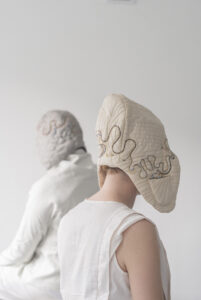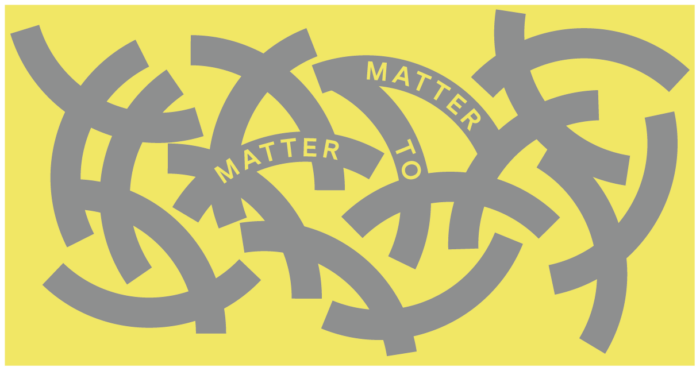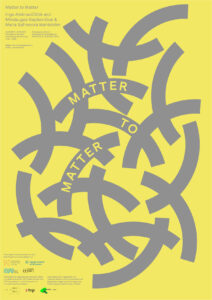Collaboration / Exhibition
‘Matter to Matter’. A Campaign-Exhibited:
4. September 2021 – 31. October 2021
Performative Event: 2. October 2021
Artists: Inga Aleknavičiūtė and Mindaugas Gapševičius & Maria Safronova Wahlström
Location: Weisse Villa, BIORAMA-Projekt, Am Wasserturm 1, 16247 Joachimsthal, UNESCO Biosphere Shorfheide-Chorin, Brandenburg, Germany.
Conventionally perceived as an exhibition, ‘Matter to Matter’ is more of a ‘Campaign of Reprise’ by artists Inga Aleknavičiūtė and Mindaugas Gapševičius & Maria Safronova Wahlström. Their mission is to sharpen human sensory perception to heighten consideration of our impact on the material world. This ‘campaign’ has arisen in response to the issue that humans increasingly shape their world for reasons of desire and pleasure as much as the need for survival and comfort. As the pace of existence accelerates the exponentially expanding pandoras box of ‘discoveries’ can never deliver enough novelty to satisfy our needs in spite of using up resources at an alarming and unsustainable rate.
In response, Aleknavičiūtė and Gapševičius understand that we are simply a component of this world, which is a continuum of energy and matter. How we read, interpret and create our world is key to improving the human condition and our biological home. In doing this they are asking simple questions:- Firstly, must we continue to be superficial creatures looking for the next material trick or are we ready to dive deeper? Secondly, to address this problem are we humans ready to look inward into the grey matter of our biological selves as well as to truly explore the depths of all matter before us?
The artists are part of a new wave of creative thinking that generates perceptive and material solutions with social and ecological ‘balance’ at their core. In chorus with a rising minority in society they demand answers, real world solutions and methods that go beyond the protected world of socio-political theories and oceans of well-meaning documents.
Aleknavičiūtė and Gapševičius have disregarded synthetic Sims type virtual world solutions to deliver tangible prototypes that present an energised and balanced future, rich in invention and in harmony with the sensual world. With these prototypes they propose to open new channels by which we can perceive and understand our environment. Their solutions are derived from hidden resources, partly biological and in part material. They suggest that we must mine ourselves as well as all of our industrialised systems to progress beyond the current solutions we know.
Altering Matter by Inga Aleknavičiūtė
“Matter cannot be created or destroyed but can change from one state to another”
In an almost alchemistic manner, Aleknavičiūtė seeks to demonstrate that materials are more or less born equal and that mainly ‘rarity’ decides their commercial fate and position as ‘Matter of desire’. The message of this installation is that it should become acceptable that ‘matter’ should be removed from the stigma of its position along the chain of use (new versus recycled) and simply taken on face value as this may be a key to a creative and ecological future. Her work comprises of a pairing of universal objects, a table and a chair formed from seemingly luxurious polished stone. These objects are examples of ‘deep recycling’ derived from materials which are foraged from far down the materials food chain. Coming from beyond the first round of ‘salvage’ which is recycled paper, they originate from a mountain of ‘De-inking sludge’, which is a residual from the paper recycling and is unusable as a fibre source. These objects are indeed created from the ‘waste of the waste’.
De-inking sludge is comprised mainly of inorganic mineral fillers, short cellulosic fibres and fines (micro fibres), coating polymers and ink particles. Less socially elevated uses are concrete, brick making and energy production. Re-engineered using Zelfo Technology’s process the material becomes clay like, reforming when pressed into a granite like material. Across the surface are organic blooms and dark flecks which betray the origins of the material as being from a non rock like source, thereby rarefying the status of this formerly anonymous ‘sludge.
The potential of Aleknavičiūtė’s source material in its original low value state not lost but simply unexposed; until now that is. To show this she has developed objects which demand that we should be looking harder at the media we use to create with, an approach that follows of a line cast by Julie Shore:- “We are materialistic in the everyday sense of the word, we are not at all materialistic enough in the true sense of the word….we should really care about the materiality of goods”.

Inga Aleknavičiūtė, Altering Matter, 2021, object surface detail, deinking sludge. Photography: Robert Piel
You and I, You and Me by Mindaugas Gapševičius & Maria Safronova Wahlström in collaboration with jewellery designer Helga Mogensen and shoe designer Leon Crayfish
The ‘Digital Wearables/Exhibits’ created by Mindaugas Gapševičius and partners allows the user to ‘super-conduct’ sensory information to the brain by tapping into the hidden lines of communication lying in and around our bodies as a means to revalue the physical world around us.
You and I, You and Me questions about the perception of the environment through electricity. The project has interactive and hybrid wearable objects, which invite the audience to experience and explore the environment, other phenomena, and the self. For example, how far could electricity help in understanding other phenomena? Is there a possibility to alter human senses by electric impulses?

Mindaugas Gapševičius & Maria Safronova Wahlström, You and I, You and Me – headwear, 2021, cloth, electronics. Photography: Bon Alog
The participatory event during the opening reception will take us to the future scenario, where humans, computing machines, and various hybrids share the space they inhabit. In this environment senses are altered, and some have inextricable linkage to computing devices. In this narrative, humans take responsibility to reshape social ties to avoid being controlled by corporations and machines. A further event is planned on 2 October 2021.
Further contributions: Sarah Phillips and Richard Hurding (mediators), Tuçe Erel (curator), Rita Valiukonytė (inspiration), Robert Piel (photography, project assistance), Veiko Liis (construction advise), Ian Erik Stewart (neuroscience consultant), Helga Mogensen (jewelry), Leon Crayfish (shoe design), Mindaugas Miselis and Alexander Selifonov (electronics), Bon Alog (video), Antanas Skučas (programing), Antanas Gerlikas (stands), Živilė Etevičiūtė, Tadas Šarūnas, Johanna Glaza (models), Başak Tüsüz (intern) and others.
The project is kindly supported by Lithuanian Council for Culture, Nordic council of Ministers, Zelfo Technology GmbH, Leipa, Lithuanian Culture Institute.
The project is organized by Institutio Media in collaboration with BIORAMA-Projekt and TOP association for the Promotion of Cultural Practice in Berlin.
Visuals: Taktika Studio
Artist Biographies
Inga Aleknavičiūtė (b. 1981) completed her degree in Scenography at the Norwegian Theatre Academy / Østfold University College and Photography at the Vilnius College of Technologies and Design. Her work is based on the study “Scenography as an Actor and the Actor as a part of Scenography”, where the artist delves into the scenarios of tension between the human body and the object in space. In 2015, she received a ‘Young Artist’ scholarship from the Norwegian Art Council for and consequently relocated to the Robert Wilson Art Residence at the Watermill Center in New York. In 2016, she founded “The International Theatre of Humanism” collective in Berlin.
Aleknavičiūtė works with theatre houses, such as the Maxim Gorki Theatre, Volksbühne, Konzerthaus, Berliner Ensemble, and elsewhere in Europe and New York. She has also worked with the ‘Zentrum für Politische Schönheit’ as a set designer for the Memorial Höcke project.
Mindaugas Gapševičius (b. 1974) completed MA studies at the Vilnius Academy of Arts and received a Master of Philosophy degree from the Goldsmiths University of London. Since 2015 he has held the position as ‘Artistic Associate’ at the Bauhaus University in Weimar. His work questions machine creativity without presuming that the human being is the sole creative force.
Maria Safronova Wahlström (b. 1989) has a background in classical painting, she moved into the field of sculpture and installation where she seeks juxtapositions of conceptual and visual form, translated through material and space. With a deep interest in social myths, she is working with themes of collective behaviour and linguistic practices that signal our social belonging. In particular, issues of relations between collective identity and individual formation, our maintenance of social boundaries and moral and ideological branding form the main field of her practice.


